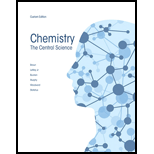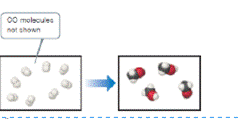
CHEMISTRY:CENTRAL SCI.-W/ACCESS>CUSTOM<
15th Edition
ISBN: 9781323233252
Author: Brown
Publisher: PEARSON C
expand_more
expand_more
format_list_bulleted
Concept explainers
Textbook Question
Chapter 12.3, Problem 12.1.1PE
The following diagram shows the combination reaction between hydrogen, H2,and carbon monoxide, CO, to produce methanol, CH30H (white spheres are H, black spheres are C, red
spheres are O). The correct number of CO molecules involved in this reaction is not shown. [Sec
3.101
a. Determine the number of CO molecules that should be shown in the left (reactants) box.
b. Write a balanced chemical equation for the reaction.

Expert Solution & Answer
Trending nowThis is a popular solution!

Students have asked these similar questions
k
https://app.aktiv.com
STARTING AMOUNT
6 58°F
Clear
+
F1
X
Dimensional Analysis - Aktiv Chemistry
Your Aktiv Learning trial expires on 02/25/25 at 02:14 PM
Question 19 of 22
Polyethylene terephthalate (PET) is used in plastic water bottles. A water bottle has a
mass of 14.0 grams. Given a density of 1.38 g/cm³, what is the volume of the
plastic used to make the water bottle in cm³ ?
ADD FACTOR
ANSWER
RESET
ว
100
14.0
0.01
10.1
1000
0.099
1.38
0.001
Q Search
F5
-O+
F6
F7
+
F3
F2
W
E
S4
ST
#3
F4
%
5
Y
R
S
&
7
cm³
g/cm³
g
ם
F8
* 00
8
F9
P
ل
DOD
S
F10
F11
F12
Insert
D
F
G
H
J
K
+ 11
A doctor gives a patient 10 Ci of beta radiation. How many betaparticles would the patient receive in 1 minute? (1 Ci = 3.7 x 1010d/s)
Part C
IN
H
N.
Br₂ (2 equiv.)
AlBr3
Draw the molecule on the canvas by choosing buttons from the Tools (for bonds and
+
e
(×)
H± 12D
T
EXP.
L
CONT.
ד
Chapter 12 Solutions
CHEMISTRY:CENTRAL SCI.-W/ACCESS>CUSTOM<
Ch. 12.3 - The following diagram shows the combination...Ch. 12.3 -
3.3 The following diagram represents the...Ch. 12.5 -
3.4 The following diagram represents the...Ch. 12.5 - Glycine, an amino acid used by organisms to make...Ch. 12.7 - The following diagram represents a...Ch. 12.7 -
3.7 Nitrogen (N2) and hydrogen (H2) react to form...Ch. 12.7 -
3.8 Nitrogen monoxide and oxygen react to form...Ch. 12.7 - Write "true" or "false" for each statement. a. We...Ch. 12 - Determine the empirical and molecular formulas of...Ch. 12 - a. Combustion analysis of toluene, a common...
Ch. 12 -
3.67 Automotive air bags infilate when sodium...Ch. 12 - Prob. 3ECh. 12 - Prob. 4ECh. 12 -
12.5 Which of these molecular fragments would...Ch. 12 - Prob. 6ECh. 12 - Prob. 7ECh. 12 - Prob. 8ECh. 12 - Prob. 9ECh. 12 - Prob. 10ECh. 12 - Prob. 11ECh. 12 - Prob. 12ECh. 12 - 12.13 Indicate the type of solid (molecular,...Ch. 12 - Prob. 14ECh. 12 -
12.15 A white substance melts with some...Ch. 12 -
12.16 You are given a white substance that...Ch. 12 - Prob. 17ECh. 12 - Prob. 18ECh. 12 - Prob. 19ECh. 12 - Prob. 20ECh. 12 - Prob. 21ECh. 12 - Prob. 22ECh. 12 - Prob. 23ECh. 12 - Prob. 24ECh. 12 - Prob. 25ECh. 12 - Prob. 26ECh. 12 - Prob. 27ECh. 12 - Prob. 28ECh. 12 - Prob. 29ECh. 12 - Prob. 30ECh. 12 - Prob. 31ECh. 12 - Prob. 32ECh. 12 - Prob. 33ECh. 12 - Prob. 34ECh. 12 - Prob. 35ECh. 12 - Prob. 36ECh. 12 - Prob. 37ECh. 12 - Prob. 38ECh. 12 - Prob. 39ECh. 12 - Prob. 40ECh. 12 - Prob. 41ECh. 12 - Prob. 42ECh. 12 - Prob. 43ECh. 12 - Prob. 44ECh. 12 - Prob. 45ECh. 12 - Prob. 46ECh. 12 - Prob. 47ECh. 12 - Prob. 48ECh. 12 -
12.49 Which would you expect to be the more...Ch. 12 - Prob. 50ECh. 12 - Prob. 51ECh. 12 - Prob. 52ECh. 12 - Prob. 53ECh. 12 - Prob. 54ECh. 12 - Prob. 55ECh. 12 - Clausthalite is a mineral composed of lead...Ch. 12 - Prob. 57ECh. 12 - Prob. 58ECh. 12 - Prob. 59ECh. 12 - Prob. 60ECh. 12 - Prob. 61ECh. 12 - Prob. 62ECh. 12 - Prob. 63ECh. 12 - Prob. 64ECh. 12 - Prob. 65ECh. 12 - Prob. 66ECh. 12 - Prob. 67ECh. 12 - Prob. 68ECh. 12 - Prob. 69ECh. 12 - Prob. 70ECh. 12 - Prob. 71ECh. 12 - Prob. 72ECh. 12 - Prob. 73ECh. 12 - Prob. 74ECh. 12 - Prob. 75ECh. 12 - Prob. 76ECh. 12 - Prob. 77ECh. 12 - Prob. 78ECh. 12 - Prob. 79ECh. 12 - Prob. 80ECh. 12 - Prob. 81ECh. 12 - Prob. 82ECh. 12 - Prob. 83ECh. 12 - Prob. 84ECh. 12 - Prob. 85ECh. 12 - Prob. 86ECh. 12 - Prob. 87ECh. 12 - Prob. 88ECh. 12 - Prob. 89ECh. 12 - Prob. 90ECh. 12 - Prob. 91ECh. 12 - Prob. 92ECh. 12 - Prob. 93ECh. 12 - Prob. 94ECh. 12 - Prob. 95ECh. 12 - Prob. 96ECh. 12 - Prob. 97ECh. 12 - Prob. 98ECh. 12 - Prob. 99AECh. 12 - Prob. 100AECh. 12 - Prob. 101AECh. 12 - Prob. 102AECh. 12 - Prob. 103AECh. 12 - What type of lattice—primitive cubic body-centered...Ch. 12 - Prob. 105AECh. 12 - Prob. 106AECh. 12 - Prob. 107AECh. 12 - Prob. 108AECh. 12 - Prob. 109AECh. 12 - Prob. 110AECh. 12 - Prob. 111AECh. 12 - Prob. 112AECh. 12 - Prob. 113AECh. 12 - 12.114 Germanium has the same structure as...Ch. 12 - Prob. 115AECh. 12 - Prob. 116AECh. 12 - The karat scale used to describe gold alloys is...Ch. 12 - Prob. 118IECh. 12 - Prob. 119IECh. 12 - Prob. 120IECh. 12 - Prob. 121IECh. 12 - Prob. 122IECh. 12 - Prob. 123IECh. 12 - Prob. 124IECh. 12 - Prob. 125IE
Knowledge Booster
Learn more about
Need a deep-dive on the concept behind this application? Look no further. Learn more about this topic, chemistry and related others by exploring similar questions and additional content below.Similar questions
- 9. OA. Rank the expected boiling points of the compounds shown below from highest to lowest. Place your answer appropriately in the box. Only the answer in the box will be graded. (3) points) OH OH بر بد بدید 2 3arrow_forwardThere is an instrument in Johnson 334 that measures total-reflectance x-ray fluorescence (TXRF) to do elemental analysis (i.e., determine what elements are present in a sample). A researcher is preparing a to measure calcium content in a series of well water samples by TXRF with an internal standard of vanadium (atomic symbol: V). She has prepared a series of standard solutions to ensure a linear instrument response over the expected Ca concentration range of 40-80 ppm. The concentrations of Ca and V (ppm) and the instrument response (peak area, arbitrary units) are shown below. Also included is a sample spectrum. Equation 1 describes the response factor, K, relating the analyte signal (SA) and the standard signal (SIS) to their respective concentrations (CA and CIS). Ca, ppm V, ppm SCa, arb. units SV, arb. units 20.0 10.0 14375.11 14261.02 40.0 10.0 36182.15 17997.10 60.0 10.0 39275.74 12988.01 80.0 10.0 57530.75 14268.54 100.0…arrow_forwardA mixture of 0.568 M H₂O, 0.438 M Cl₂O, and 0.710 M HClO are enclosed in a vessel at 25 °C. H₂O(g) + C₁₂O(g) = 2 HOCl(g) K = 0.0900 at 25°C с Calculate the equilibrium concentrations of each gas at 25 °C. [H₂O]= [C₁₂O]= [HOCI]= M Σ Marrow_forward
- What units (if any) does the response factor (K) have? Does the response factor (K) depend upon how the concentration is expressed (e.g. molarity, ppm, ppb, etc.)?arrow_forwardProvide the structure, circle or draw, of the monomeric unit found in the biological polymeric materials given below. HO OH amylose OH OH 행 3 HO cellulose OH OH OH Ho HOarrow_forwardWhat units (if any) does K have? Does K depend upon how the concentration is expressed (e.g. molarity, ppm, ppb, etc.)? in calculating the response factorarrow_forward
- Don't used hand raiting and don't used Ai solutionarrow_forwardDon't used Ai solution and don't used hand raitingarrow_forwardOA. For the structure shown, rank the bond lengths (labeled a, b and c) from shortest to longest. Place your answer in the box. Only the answer in the box will be graded. (2 points) H -CH3 THe b Нarrow_forward
- Don't used hand raitingarrow_forwardQuizzes - Gen Organic & Biological Che... ☆ myd21.lcc.edu + O G screenshot on mac - Google Search savings hulu youtube google disney+ HBO zlib Homework Hel...s | bartleby cell bio book Yuzu Reader: Chemistry G periodic table - Google Search b Home | bartleby 0:33:26 remaining CHEM 120 Chapter 5_Quiz 3 Page 1: 1 > 2 > 3 > 6 ¦ 5 > 4 > 7 ¦ 1 1 10 8 ¦ 9 a ¦ -- Quiz Information silicon-27 A doctor gives a patient 0.01 mC i of beta radiation. How many beta particles would the patient receive in I minute? (1 Ci = 3.7 x 10 10 d/s) Question 5 (1 point) Saved Listen 2.22 x 107 222 x 108 3.7 x 108 2.22 x 108 none of the above Question 6 (1 point) Listen The recommended dosage of 1-131 for a test is 4.2 μCi per kg of body mass. How many millicuries should be given to a 55 kg patient? (1 mCi = 1000 μСi)? 230 mCiarrow_forwardDon't used hand raiting and don't used Ai solutionarrow_forward
arrow_back_ios
SEE MORE QUESTIONS
arrow_forward_ios
Recommended textbooks for you
 Chemistry for Engineering StudentsChemistryISBN:9781337398909Author:Lawrence S. Brown, Tom HolmePublisher:Cengage Learning
Chemistry for Engineering StudentsChemistryISBN:9781337398909Author:Lawrence S. Brown, Tom HolmePublisher:Cengage Learning Chemistry for Engineering StudentsChemistryISBN:9781285199023Author:Lawrence S. Brown, Tom HolmePublisher:Cengage Learning
Chemistry for Engineering StudentsChemistryISBN:9781285199023Author:Lawrence S. Brown, Tom HolmePublisher:Cengage Learning ChemistryChemistryISBN:9781305957404Author:Steven S. Zumdahl, Susan A. Zumdahl, Donald J. DeCostePublisher:Cengage Learning
ChemistryChemistryISBN:9781305957404Author:Steven S. Zumdahl, Susan A. Zumdahl, Donald J. DeCostePublisher:Cengage Learning
 Chemistry: An Atoms First ApproachChemistryISBN:9781305079243Author:Steven S. Zumdahl, Susan A. ZumdahlPublisher:Cengage Learning
Chemistry: An Atoms First ApproachChemistryISBN:9781305079243Author:Steven S. Zumdahl, Susan A. ZumdahlPublisher:Cengage Learning Chemistry & Chemical ReactivityChemistryISBN:9781337399074Author:John C. Kotz, Paul M. Treichel, John Townsend, David TreichelPublisher:Cengage Learning
Chemistry & Chemical ReactivityChemistryISBN:9781337399074Author:John C. Kotz, Paul M. Treichel, John Townsend, David TreichelPublisher:Cengage Learning

Chemistry for Engineering Students
Chemistry
ISBN:9781337398909
Author:Lawrence S. Brown, Tom Holme
Publisher:Cengage Learning

Chemistry for Engineering Students
Chemistry
ISBN:9781285199023
Author:Lawrence S. Brown, Tom Holme
Publisher:Cengage Learning

Chemistry
Chemistry
ISBN:9781305957404
Author:Steven S. Zumdahl, Susan A. Zumdahl, Donald J. DeCoste
Publisher:Cengage Learning


Chemistry: An Atoms First Approach
Chemistry
ISBN:9781305079243
Author:Steven S. Zumdahl, Susan A. Zumdahl
Publisher:Cengage Learning

Chemistry & Chemical Reactivity
Chemistry
ISBN:9781337399074
Author:John C. Kotz, Paul M. Treichel, John Townsend, David Treichel
Publisher:Cengage Learning
Bonding (Ionic, Covalent & Metallic) - GCSE Chemistry; Author: Science Shorts;https://www.youtube.com/watch?v=p9MA6Od-zBA;License: Standard YouTube License, CC-BY
Stoichiometry - Chemistry for Massive Creatures: Crash Course Chemistry #6; Author: Crash Course;https://www.youtube.com/watch?v=UL1jmJaUkaQ;License: Standard YouTube License, CC-BY